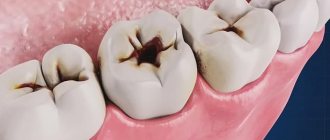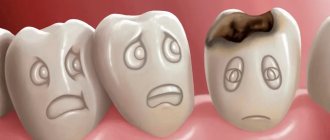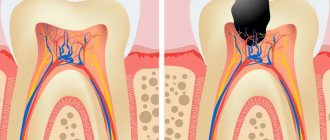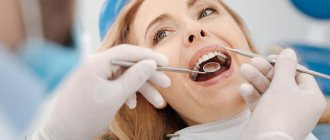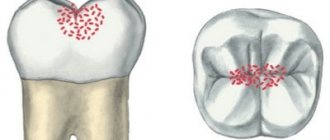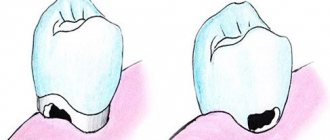Deep caries is the fourth and final stage of destruction and demineralization of hard tooth tissues. Looking at the photo of deep caries, you can immediately notice the presence of a carious hollow. From the outside it may seem small, but inside there is always significant destruction of dental tissue.
With deep caries, the carious cavity is separated from the pulp by only a narrow layer of dentin, which with further development of the disease can lead to the development of pulpitis, periodontitis or periostitis. Thus, the main task of the dentist is to preserve all the functions of the tooth and minimize the risk of developing these diseases.
Etiology
The medical history of deep caries may indicate the primary or secondary development of the disease. In the first case, it occurs due to the lack of professional treatment of the middle stage of caries, in the second - after tooth preparation (incorrect treatment, chipped filling). Otherwise, the factors stimulating the development of the disease are the same as for caries in general: poor hygiene, lack of necessary cleaning of hard-to-reach places, disturbances in pH levels, saliva composition, genetic predisposition.
In our clinic you can get a free dental consultation!
Complicated caries in children
In children and adolescents, complications, like the caries that precede them, develop at lightning speed. This is due to insufficient mineralization of enamel in childhood and the tendency of young patients to infectious diseases caused by streptococci - sore throat, bronchitis, measles and scarlet fever.
Advanced forms of caries in children lead to:
- the development of its circular shape, when, starting from the neck of the tooth, decay spreads around its crown, and over time the tooth breaks off;
- spread of infection along the surface of the crown (planar caries). In this case, the tooth completely darkens, the child complains of aching pain;
- acute and chronic pulpitis;
- infection of the rudiments of permanent teeth, resulting in multiple caries after their eruption.
Our doctors
18 years of experience
Baghdasaryan
Armen Evgenievich
Chief physician, dentist-orthopedist-therapist
Graduated from VSMA named after. N.N. Burdenko. Internship on the basis of MGMSU named after. A.E. Evdokimov in “General Dentistry”.
Clinical residency at the Moscow State Medical University named after. A.E. Evdokimov in “Orthopedics”.
More about the doctor...
5 years experience
Sadina
Ekaterina Vladislavovna
Dental therapist, surgeon
Penza State University Medical Institute, specialty “Dentistry”.
In 2016, she underwent professional retraining in the specialty “Therapeutic Dentistry” at the Moscow State Medical and Dental University named after A.I. Evdokimov.
More about the doctor...
8 years of experience
Arzumanov
Andranik Arkadievich
Dentist-orthodontist
Graduated from Moscow State Medical University. Internship - Moscow State Medical University at the Department of Orthodontics and Children's Prosthetics.
Residency at Moscow State Medical University at the Department of Orthodontics and Children's Prosthetics. Member of the Professional Society of Orthodontists of Russia since 2010.
More about the doctor...
DIFFERENCE OF SECONDARY CARIES FROM RECURRENCE
A carious lesion under a filling (in dental practice - secondary caries ICD K02.8) is the re-formation of a lesion under a previously placed composite material. The root cause of this process is bacteriological microorganisms, filling cracks and hard tissue structures of the tooth. The diagnosis of secondary caries includes the involvement of intact enamel near the material
Recurrent caries process is the resumption of pathology in the treated area. Such relapses of the disease can be caused by a violation by a dental specialist of the protocol for treating the formed cavity: a zone of preventive expansion is not created and drug treatment is not carried out.
The occurrence of recurrent and secondary pathology can occur at the same time, and choosing a specific cause for the formation of pathology is very difficult.
SIGNS OF PATHOLOGY
Symptoms such as:
- change in shade of the entire filling material or along the edges;
- the seal is not tight (food residue gets stuck);
- enamel chips;
- reaction to changes in temperature or sweet/salty;
- unpleasant odor from the mouth;
- aching pain in a previously treated unit;
- the formation of inflammation in the adjacent gingival and mucous tissues.
If there are visible changes on the crown part of the tooth and the composite material, you must immediately make an appointment for a consultation with a dentist. A reason for concern in case of secondary caries, the reason for recording will be a change in the color shade of the filling or the formation of dark zones on the enamel. An acute painful condition is an indicator of an advanced stage of the pathological process, which means that treating such a unit will be more difficult and longer.
Clinical manifestations
Symptoms of deep caries, first of all, consist of a sharp toothache when exposed to thermal, chemical or mechanical stimuli. The pain is short-term and disappears after the stimulus is removed. If pieces of food remain in the cavity, the pain becomes aching and can last until the irritants are eliminated. If the carious cavity is extensive, the patient may develop an unpleasant putrid odor from the mouth. Caries under a filling can develop for years and is characterized by the absence of clinical manifestations. Painful sensations occur only when the dentin is destroyed to the bottom of the tooth.
Causes and types of complications
The culprits in the development of caries and its complications are streptococcus bacteria – Streptococcus sanguis, mutans, viridans. These pathogenic microorganisms oxidize and destroy tooth enamel, and then penetrate deep into the hard tissue through the dentin canals.
In the absence of proper treatment, the infection affects the coronal part of the soft tissue, the pulp, and the first stage of complicated caries occurs - acute pulpitis.
Pulpitis
When the infection reaches the pulp, an inflammatory process begins in the neurovascular bundle of the tooth in the form of:
- acute focal;
- diffuse (general) pulpitis,
a characteristic symptom of which is severe, throbbing pain in the tooth and increased sensitivity to cold.
If you do not go to the dentist with pulpitis in the first 2-3 days, the acute stage of the complication becomes chronic and develops:
- fibrous;
- hypertrophic;
- concretory;
- or gangrenous chronic pulpitis.
With chronic pulpitis, the inflamed tissue of the neurovascular bundle degenerates and is gradually destroyed, dentin formation in the tooth stops, and it becomes dead.
Over time, decay processes reach the peri-apical tissues and ligamentous apparatus - periodontium.
Periodontitis
Between the root of the tooth and the alveolus there are periodontal tissues, they act as a shock absorber during chewing and hold the tooth in the socket.
With periodontal inflammation, periodontitis, the integrity of the tooth ligaments is disrupted, the jawbone becomes infected and damaged.
Symptoms of acute periodontitis:
- acute pain when biting or touching a tooth with the tongue;
- pain is transmitted along the trigeminal nerve - to the temple and jaw;
- general malaise, deterioration of health;
- increase in body temperature to 37-38 degrees.
The acute phase with severe pain lasts from 2 to 14 days, after which the disease takes on a chronic form.
With chronic fibrous or granulating periodontitis, a fistula, that is, a through hole, can form in the gum. Patients also complain of a feeling of the diseased tooth moving out of its row and attacks of aching pain.
Granuloma
An advanced form of chronic periodontitis, granulomatous, leads to the formation of a capsule with exudate (pus) at the apex of the tooth - granulomas.
The gums of the diseased tooth become inflamed, patients complain of a feeling of bulging bone and persistent, severe pain.
A granuloma that is not eliminated in time can cause the formation of gumboil or a cyst at the root of the tooth.
Multiple caries
Another common type of complication is multiple (acute, blooming) caries, in which the infection simultaneously affects the coronal part of eight or more teeth.
In record time, caries destroys the enamel-dentin junction, penetrates the pulp and leads to tooth loss. The infection affects the cement on the roots of adjacent teeth, and the patient feels as if the entire dental arch hurts. Most often, multiple caries is detected in people with diabetes and preschool children.
Diagnostics
Deep caries is diagnosed during an examination by a dentist, who takes into account the patient’s complaints, examination results, thermal diagnostics and radiography data. Differential diagnosis of deep caries requires distinguishing it from the following diseases:
- periodontitis;
- pulpitis;
- average caries.
WHEN SHOULD OLD FILLINGS BE CHANGED?
Replacing old fillings is a method of treating and preventing secondary caries. This makes it easier to prevent the disease from getting worse and treat it conservatively in one visit to a specialist. Therefore, old fillings that have stood for more than 5 years should be changed if:
- the tight fit of the filling to the tooth is broken, i.e. pieces of food get stuck between the material and the walls of the cavity, there is a high risk of damage to hard tissues;
- there is excess material and it “hangs” over the neighboring unit or gum, which causes a local inflammatory reaction on the gum, bleeding and the risk of destruction of the root system of the unit due to the accumulation of food and pathological microorganisms;
- abrasion of the filling has occurred, which over time leads to bite pathology and problems with the TMJ;
- The filling material did not restore the anatomy of the chewing surface, i.e. has changed the natural shape, and thus increases the risks of joint diseases;
- the aesthetics are impaired, especially the frontal group of teeth, which are visible when smiling;
It turns out that replacing fillings is important because of maintaining the health of teeth and gum tissue. If the attending physician considers it necessary to replace an outdated filling, you should agree for the sake of continued oral health.
Treatment
Treatment of deep caries is carried out in several stages and sometimes requires two visits to the dentist. The latter is necessary if the dentist is not sure that the disease has not affected the pulp. In this case, the treatment plan includes the following:
- treatment of the carious cavity and removal of all affected tissues;
- applying an insulating pad;
- installation of a temporary filling;
- a second visit after three to four days and installation of a permanent filling if there is no pain.
If pain symptoms are present and increasing, pulpitis is treated.
Prevention of caries
It is impossible to cure caries at home, but you can prevent its occurrence. To do this, it will be useful to resort to a number of preventive measures to strengthen tooth enamel, which will increase its resistance to chemical destruction. It will be useful:
- Avoid consuming sugary foods and drinks to prevent the growth of microorganisms in your mouth. Well, if you still decide to eat them, you should regularly rinse your mouth after eating.
- Regularly use toothpastes containing fluoride to brush your teeth. This microelement strengthens the enamel, making it resistant to acid and the formation of caries.
- Using dental floss daily will effectively remove food particles stuck between your teeth that cannot be removed with a standard brush.
Strict adherence to basic hygiene rules and proper balanced nutrition will help keep your teeth and gums healthy. It would be a good idea to make a habit of regularly visiting the dentist - the disease will be noticed in the early stages of manifestation, which will avoid the need for filling.
Where to treat?
You can undergo treatment for deep caries at the Good Hands dental clinic. Our specialists will make every effort to save the tooth and carry out its restoration, maintaining its appearance and functionality. It is very important to seek professional dental care in a timely manner in order to prevent the development of pulpitis and periodontitis, which can lead to tooth loss. Our specialists use effective anesthetics and modern equipment in their work. Thanks to this, the treatment will be comfortable and painless. Book a free consultation with us by filling out the simple form on this page or calling us!
Causes of caries
Multiplying carious bacteria, feeding on food debris on the teeth and releasing acidic products, slowly destroy the enamel. The disease develops at different rates in different people. It's connected with:
- Heredity.
It has a strong influence on the composition and structure of dental tissues, and if parents suffered from manifestations of the disease, then with a high degree of probability this will also be characteristic of their child. - Food.
Carious bacteria feed mainly on sucrose and a number of other complex carbohydrates, and eating sweets can lead to their rapid growth, an increase in the amount of waste products and to the decay of enamel. - Features of the immune system.
Often, caries develops after a person has suffered respiratory diseases, which is associated with weakened oral immunity, which causes the proliferation of microorganisms. - Brushing your teeth.
Many people neglect this hygiene procedure, or do it irregularly and for show. This leads to the formation of plaque, which is a favorable environment for the proliferation of microorganisms. - Profession.
People who work in enterprises associated with the production of chemicals are statistically more likely to become ill. - Geography.
The percentage of fluoride in drinking water, which is responsible for strengthening tooth enamel, leads to an uneven spread of the disease depending on the region.
PREVENTIVE ACTIONS
To reduce the risk of pathology formation, it is important for patients to perform secondary prevention of caries:
- install composite inlays and crowns from modern materials;
- follow all the specialist’s recommendations during and after treatment;
- when identifying the first violations of the structure of the material, it is important to make an appointment with a doctor;
- come for preventive examinations once every six months, even without obvious complaints.
Compliance with all simple rules will make it possible to minimize the risk of a secondary process. It is important to find an experienced doctor to perform treatment. That is why, when choosing a clinic, you should pay attention to prices, patient reactions after an appointment, and the qualifications of doctors.
By making an appointment with us at West Dental, you make your choice to use the best specialists and high-tech equipment and perform treatment procedures with modern materials, so the occurrence of secondary pathology will be minimal.

